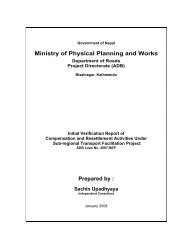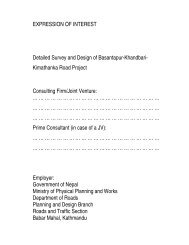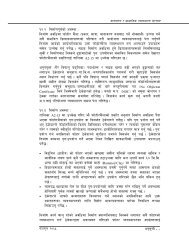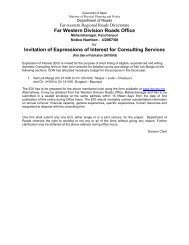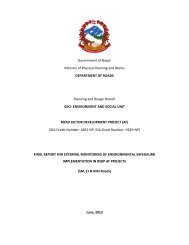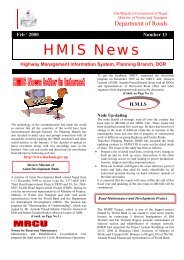Environmental & Social Management Framework - About ...
Environmental & Social Management Framework - About ...
Environmental & Social Management Framework - About ...
Create successful ePaper yourself
Turn your PDF publications into a flip-book with our unique Google optimized e-Paper software.
<strong>Environmental</strong> and <strong>Social</strong> <strong>Management</strong> <strong>Framework</strong>The environmental laws stipulate the requirements and procedures for theapproval process of the <strong>Environmental</strong> Assessment. Section 3 to 6 of the EPA,1996 and Rule- 3 to 11 of the EPR, 1997contain such provisions, Rule 12 of theEPR, 1997 (first amendment 1999) requires the proponent to comply with thematters mentioned in the report and other conditions, if any, prescribed by theapproving agency or concerned agency, while Rule 13 and 14 are related toenvironmental monitoring and environmental auditing.The environmental legislation empowers concerning Ministry to monitor theenvironmental activities including mitigation measures and the then MoPE (nowMoEST) for environmental auditing. For IEE, the concerning Ministry, which isMinistry of Physical Planning and Works in case of the proposed Project, isauthorized to approve the Final IEE Report. The EPR also lists the environmentalscreening through depicting the types of development activities requiring IEE orEIA Level Study. It also gives an outline of content of Terms of Referencedocument, IEE and EIA Report.The preparation of <strong>Environmental</strong> <strong>Management</strong> Plan (EMP) is determined as akey part of the EIA report. The proponent is required to implement the mitigationmeasures, while the environmental monitoring works should be performed by theconcerned agency (ministries), and auditing by the Ministry of Population andEnvironment (the then MoPE (now MoEST) in accordance with the provisions ofthe EPR, 1997.The environmental law has made the public consultation a pre-requisite to all theprescribed projects to provide different stakeholders an opportunity to raise theirconcerns right from the Project Scoping stage to the approval of EIA Report.Provision of intense public participation and consultation has been mademandatory for EIA through Public consultation during Scoping and Public Hearingafter Draft Report Preparation. Such participation of the related stakeholders takeplace during entire period of preparation of EIA report. Section 18 of the EPA,1996 empowers the prescribed authority to close down such act immediately andimpose fine up to one hundred thousand rupees in case any person implementsa proposal requiring environmental assessment without any approval or carriesany act in contrary to the approved proposal.3.3.3 Soil and Watershed Conservation Act, 1982In order to properly manage the watersheds of Nepal, the Soil and WatershedConservation act, 1982 was enacted. Section 3 of the act empowers thegovernment to declare any area as a protected watershed area. Section 4 of theact provides that a watershed conservation officer has the authority to implementthe following works in protected watershed areas:• Construct and maintain dam, embankment, terrace improvements,diversion channels and retaining walls• Protect vegetation in landslide-prone areas and undertake afforestationprograms, and• Regulate agricultural practices pertinent to soil and watershedconservation.Under Section 10 of the act, power is extended to the Watershed ConservationOfficer to grant permission to construct dams, drainage ditches, canals, cutprivately owned trees, excavate sand, boulders and soil, discharge solid waste,and establish industry or residential areas within any protected watershed. TheAct outlines the essential parameters necessary for proper watershedmanagement (including rivers and lakes). The act is applicable to protectedwatersheds.April 2007 Chapter 3-3



![j:6 ]zg cfof ]hgf](https://img.yumpu.com/51286794/1/190x245/j6-zg-cfof-hgf.jpg?quality=85)

![x'nfsL /fhdfu { cfof ]hgf](https://img.yumpu.com/50581959/1/190x245/xnfsl-fhdfu-cfof-hgf.jpg?quality=85)
